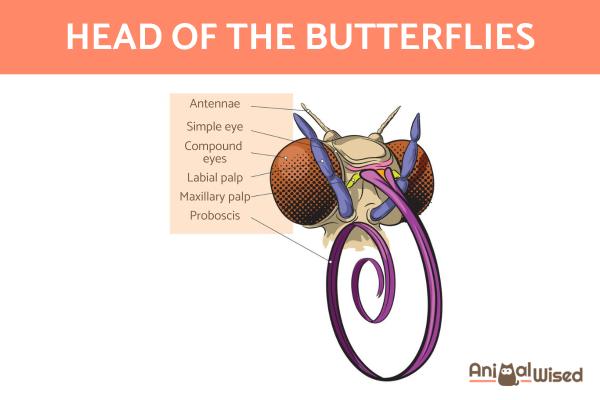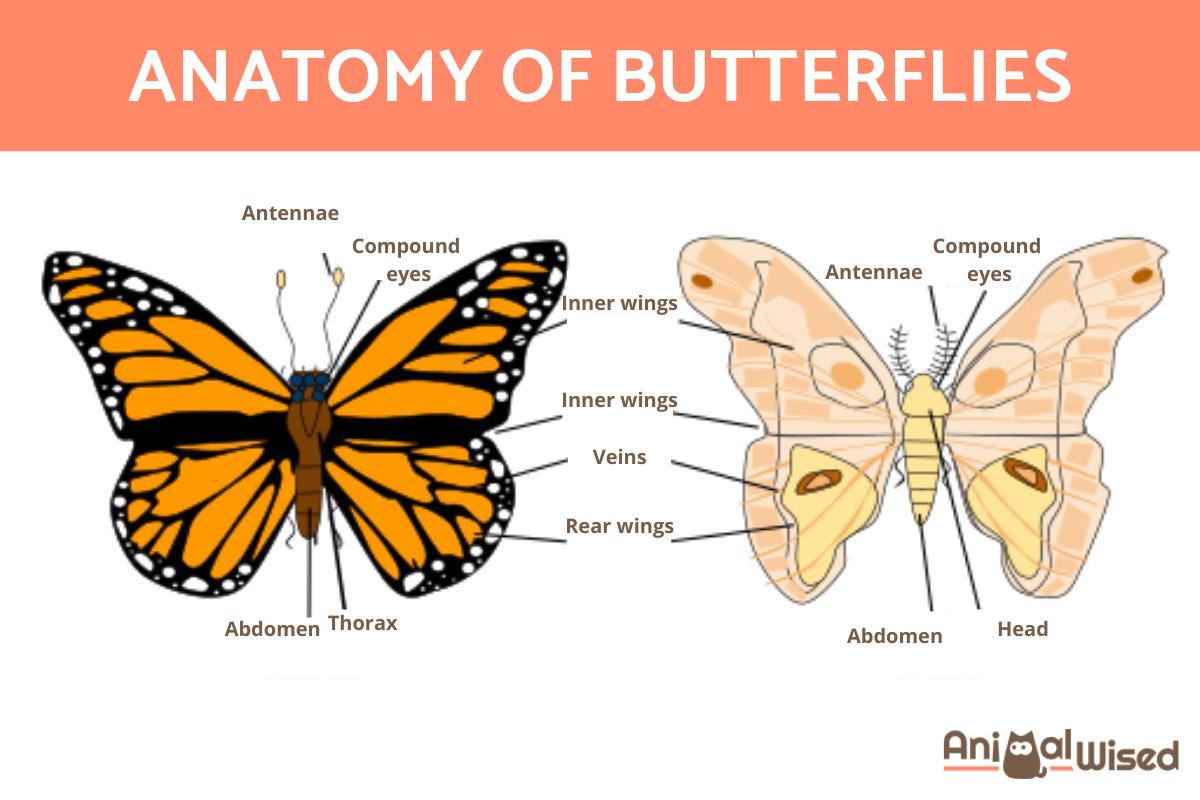Body Parts of a Butterfly and Their Functions


Insects are the most diverse class of arthropods on our planet, exhibiting a wide variety of characteristics and adaptations. Depending on the species, they can walk, fly or swim and have conquered an infinite number of habitats. Insects differ from one another in their anatomical, biological, and ecological characteristics, even though they share certain features in common.
The following AnimalWised article explains the different body parts of a butterfly, as well as their main characteristics.
Main characteristics of butterflies
The popular name butterfly refers to the various species of Lepidoptera insects. Their name comes from the Greek, lepsis means "scales," and pteron means "wings". They are among the most numerous insects on our planet. There are about 165,000 different species of butterflies, divided into 127 families.
Butterflies have attracted the attention of humans since ancient times. This is partly due to the amazing colors and wing patterns of diurnal butterflies and their attraction to flowers. In addition, their larvae, the caterpillars, provide food for numerous types of creatures in nature. Some common characteristics of butterflies are:
- They undergo complete metamorphosis: this means that their life cycle includes the egg, larva or caterpillar, pupa, and adult stages. At each stage of complete metamorphosis, the animal looks different from all other stages. This is different from incomplete metamorphosis, where the early stages of development look like tiny versions of the adult.
- They are both diurnal and nocturnal: Butterflies are flying animals that are mostly active at night. However, we know the diurnal species (butterflies themselves) much better than the nocturnal species (called moths).
- They are widespread: they are found all over the world, except for Antarctica.
- They are migratory animals: many butterfly species migrate hundreds of miles from one place to another to reproduce and spawn, depending on climatic conditions.
- They use their colorful wings for protection: their bright wings are their natural defense mechanism and serve as a warning to potential predators that they are poisonous. When camouflage fails, some moths and butterflies defend themselves by suddenly displaying bright colors or patterns under their dull upper wings. This can cause a startled predator to retreat.
- They are arthropods and insects: that is, they have a segmented body with jointed limbs and a chitinous exoskeleton covering them.
If you want to know more about the life cycle of butterflies, you should not miss the following article, where we talk about how long the life cycle of a butterfly is.
Head of the butterfly
The head of the butterfly is small, roundish, and this is where the sense organs are located. Some parts of the butterfly that are in its head are:
Eyes
Butterfly eyes are made up of thousands of tiny eyes called ommatidia. This type of structure is called compound eyes. Each ommatidium is an independent unit for photoreception, consisting of a cornea, a lens, and photoreceptor cells. Thanks to the mosaic vision of this type of eyes, they can perceive movement as well as colors and patterns.
Mouth
The mouth of butterflies is called spirorhombus. It is of a long tube with which the animal sucks nectar from flowers and then collects it by rolling it up into a spiral. Also on the head, near the mouth, we find some appendages known as palps, which have olfactory receptors, as this is a particularly developed sense in these animals.
Antennas
The antennae are other structures located on the head of the butterfly. They are characterized by being long, filiform, and segmented. The antennae of butterflies have several functions, for example, they serve as a rocker while they fly. They combine the senses of smell and touch, since each antenna is covered with dimples in which bristles or hairs can be seen, which are precisely the receptors of the senses.
If you want to know more about butterflies and how they differ from moths, you should not miss the following article, where we talk about the main differences between moths and butterflies.

Thorax of the butterfly
Another part of the butterflies' body is the thorax, which corresponds to the average structure of the body and consists of three fused segments made of chitin. The parts of the butterfly that we find in the thorax are the following.
- Prothorax: here are the first two legs and the respiratory openings known as spiracles, which are connected to a complex system of tubes involved in gas exchange.
- Mesothorax: it is larger and contains the other two legs of the butterfly, two more spiracles and the forewings.
- Metathorax: it contains the third pair of legs and the hind wings.
An important aspect is that in the thorax there are powerful muscles that allow the movement of the wings. These last structures make it possible that they are flying insects, and they are covered with thousands of scales that can have different pigments. In this way, they give the butterflies their beautiful colors and particular patterns that vary from one group to another.
On the other hand, it is worth mentioning that the legs of butterflies are composed of three segments: Femur, tibia and tarsus. These limbs also have receptors that allow them to perceive signals from the environment, such as vibrations, smells and tastes.
If you want to learn more about butterflies, do not miss the following article, where we explain how butterflies are born.

Abdomen of the butterfly
The abdomen is flexible and has a cylindrical shape. It consists of 10 segments, the last two of which are usually modified to be part of the reproductive system. In the abdomen, there are also spiracles, which correspond to the respiratory system of these insects.
The abdomen of the butterfly body consists of the following parts:
- Digestive system: it begins in the animal's mouth, which is responsible for processing the mainly liquid food that these insects ingest.
- Circulatory system: it consists of a tubular heart that carries the hemolymph, the blood of these arthropods, through a single tube, the dorsal aorta. Nutrients flow through this aorta to the rest of the body.
- Excretory system: this system consists of a complex of Malpighian tubes that cooperate with specialized glands and the rectum, so that the waste produced is excreted, but in a very efficient way, as fluid loss is regulated.
- Reproductive organs: it varies not only between males and females, but also between species that allow reproduction only between members of their own species. In females, this area of the abdomen is rounder and thicker than in males. Females have ovaries, oviducts, genital chambers and ovipositor, which are specific structures within this system. Males, on the other hand, have a penis, vas deferens and testes.
If you want to learn more about the way butterflies reproduce, do not miss the following article where we talk about butterfly reproduction:
If you want to read similar articles to Body Parts of a Butterfly and Their Functions, we recommend you visit our Facts about the animal kingdom category.
- Boyero, A. and López, J. (1998). Guide to butterflies in the northern area of the Parque del Suroeste . Available at: https://www.elsoto.org/wp-content/uploads/2015/08/folleto_libro_mariposas.pdf
- Culin, Jose. " Lepidoptera ". Encyclopedia Britannica, January 12, 2018, https://www.britannica.com/animal/lepidopteran.
- García, E., Romo, E., Sarto, V., Munguira, M., Baixeras, J., Vives, A., and Yela, J. (2015). Order Lepidoptera . Available at: http://sea-entomologia.org/IDE@/revista_65.pdf
- Lepidoptera Society (2016). Anatomical Terms for Lepidoptera . Available at: https://web.archive.org/web/20160507010553/http://www.lepsoc.org/anatomical_definitions.php







